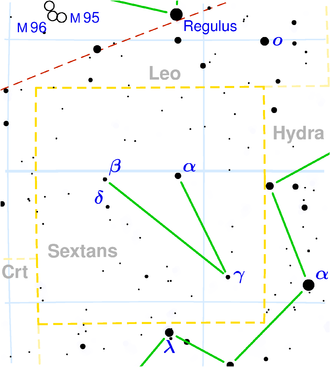NGC 3341
| Galaxy NGC 3341 |
|
|---|---|

|
|
| SDSS recording | |
| AladinLite | |
| Constellation | sextant |
|
Position equinox : J2000.0 , epoch : J2000.0 |
|
| Right ascension | 10 h 42 m 31.5 s |
| declination | + 05 ° 02 ′ 38 ″ |
| Appearance | |
| Morphological type | PECULAR / AGN |
| Brightness (visual) | 13.8 mag |
| Brightness (B-band) | 14.8 mag |
| Angular expansion | 1.2 '× 0.4' |
| Position angle | 24 ° |
| Surface brightness | 12.9 mag / arcmin² |
| Physical data | |
| Redshift | 0.027339 ± 0.000127 |
| Radial velocity | 8196 ± 38 km / s |
|
Stroke distance v rad / H 0 |
(361 ± 25) · 10 6 ly (110.6 ± 7.8) Mpc |
| history | |
| discovery | Albert Marth |
| Discovery date | March 22, 1865 |
| Catalog names | |
| NGC 3341 • UGC 5831 • PGC 31915 • CGCG 037-124 • MCG + 01-27-031 • 2MASX J10423147 + 0502382 • GALEX ASC J104231.60 + 050237.0 • LDCE 746 NED005 | |
NGC 3341 is a merging galaxy with active galaxies core from the Hubble type P in the constellation Sextant south of the celestial equator . It is estimated to be 361 million light years away from the Milky Way and has a diameter of about 130,000 ly.
In the same area of the sky are the galaxies NGC 3326 , NGC 3337 , IC 636 .
The object was discovered by Albert Marth on March 22, 1865 .
